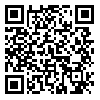Volume 28 - Supplementary
IBJ 2024, 28 - Supplementary: 10-10 |
Back to browse issues page
Download citation:
BibTeX | RIS | EndNote | Medlars | ProCite | Reference Manager | RefWorks
Send citation to:



BibTeX | RIS | EndNote | Medlars | ProCite | Reference Manager | RefWorks
Send citation to:
Rahimi M, Zarimeidani F, Bahreini H S, Kadkhodaei A, Rahmati R, Raeisi Shahraki H. Can Personality Traits Be Linked to the Development of Alexithymia? Findings from a Cross-Sectional Study. IBJ 2024; 28 :10-10
URL: http://ibj.pasteur.ac.ir/article-1-4380-en.html
URL: http://ibj.pasteur.ac.ir/article-1-4380-en.html
Maedeh Rahimi 
 , Fatemeh Zarimeidani
, Fatemeh Zarimeidani 
 , Hedieh Sadat Bahreini
, Hedieh Sadat Bahreini 
 , Atena Kadkhodaei
, Atena Kadkhodaei 
 , Rahem Rahmati
, Rahem Rahmati 
 , Hadi Raeisi Shahraki *
, Hadi Raeisi Shahraki * 


 , Fatemeh Zarimeidani
, Fatemeh Zarimeidani 
 , Hedieh Sadat Bahreini
, Hedieh Sadat Bahreini 
 , Atena Kadkhodaei
, Atena Kadkhodaei 
 , Rahem Rahmati
, Rahem Rahmati 
 , Hadi Raeisi Shahraki *
, Hadi Raeisi Shahraki * 

Abstract:
Introduction: Scientists have discovered that alexithymia poses a significant challenge for students, surpassing other academic and non-academic issues. Its non-clinical nature implies that individuals afflicted with this condition often fail to realize they are experiencing a problem unless they possess sufficient mental health awareness and understanding. Therefore, this research aimed to explore the correlation between students' personality traits and alexithymia within the student population.
Methods and Materials: Following the approval from the ethics committee, for this cross-sectional investigation, a total of 290 students enrolled in the first semester of the 2019-2020 academic year at Shahrekord University of Medical Sciences was chosen using a multi-stage cluster sampling approach. Standardized questionnaires, specifically the NEO-FFI (Five Factor Model) and the TAS-20 (Toronto Alexithymia Scale), were employed to assess alexithymia and personality traits. To compare the scores of various personality traits between students with and without alexithymia, an independent t-test using SPSS 21.0 software was conducted. Additionally, the logistic regression model was utilized to examine the adjusted associations.
Results: Among 290 students, the average age of the participants in this study was 22.6 + 3.8 years. Most students were female (77.9%) and single (88.5%). Based on the TAS-20 assessment, 43.8% exhibited symptoms of alexithymia. Among these students, the neuroticism trait was significantly higher than the non-alexithymic students (27.20 ± 3.90 versus 25.48 ± 4.90; p = 0.01), indicating a greater tendency toward emotional instability. Additionally, the average score for the conscientiousness trait was significantly higher in the alexithymic students (20.16 ± 3.84 versus 21.58 ± 5.00; p = 0.01), suggesting a greater inclination towards being organized and responsible. The logistic regression analysis results indicated that for each unit increase in the neuroticism trait, there was a 10% increase in the odds of experiencing alexithymia. Conversely, for each unit increase in the score of conscientiousness trait, there was an 8% decrease in the odds of experiencing alexithymia.
Conclusion and Discussion: Given the notable correlation between personality traits and alexithymia, improving screening methods and intervention programs focusing on personality traits can help prevent or alleviate the symptoms among university students. Targeted interventions can be developed to support and assist students experiencing this condition by identifying and addressing specific personality traits associated with alexithymia.
Methods and Materials: Following the approval from the ethics committee, for this cross-sectional investigation, a total of 290 students enrolled in the first semester of the 2019-2020 academic year at Shahrekord University of Medical Sciences was chosen using a multi-stage cluster sampling approach. Standardized questionnaires, specifically the NEO-FFI (Five Factor Model) and the TAS-20 (Toronto Alexithymia Scale), were employed to assess alexithymia and personality traits. To compare the scores of various personality traits between students with and without alexithymia, an independent t-test using SPSS 21.0 software was conducted. Additionally, the logistic regression model was utilized to examine the adjusted associations.
Results: Among 290 students, the average age of the participants in this study was 22.6 + 3.8 years. Most students were female (77.9%) and single (88.5%). Based on the TAS-20 assessment, 43.8% exhibited symptoms of alexithymia. Among these students, the neuroticism trait was significantly higher than the non-alexithymic students (27.20 ± 3.90 versus 25.48 ± 4.90; p = 0.01), indicating a greater tendency toward emotional instability. Additionally, the average score for the conscientiousness trait was significantly higher in the alexithymic students (20.16 ± 3.84 versus 21.58 ± 5.00; p = 0.01), suggesting a greater inclination towards being organized and responsible. The logistic regression analysis results indicated that for each unit increase in the neuroticism trait, there was a 10% increase in the odds of experiencing alexithymia. Conversely, for each unit increase in the score of conscientiousness trait, there was an 8% decrease in the odds of experiencing alexithymia.
Conclusion and Discussion: Given the notable correlation between personality traits and alexithymia, improving screening methods and intervention programs focusing on personality traits can help prevent or alleviate the symptoms among university students. Targeted interventions can be developed to support and assist students experiencing this condition by identifying and addressing specific personality traits associated with alexithymia.

| Rights and permissions | |
 |
This work is licensed under a Creative Commons Attribution-NonCommercial 4.0 International License. |





.png)
